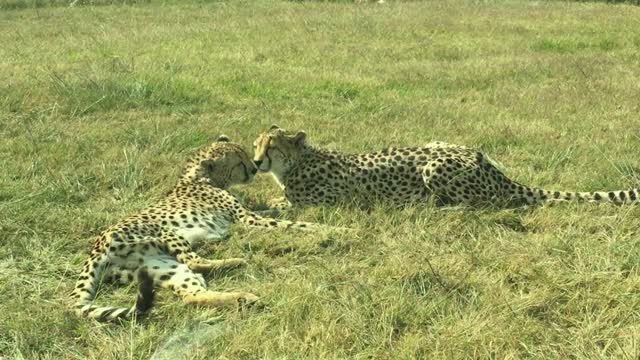Premium Only Content

THE TWO LEOPARDS WITH EACH OTHER
/ LEOPARD - Competition can have profound impacts on the structure and function of ecological communities. Despite this, the population-level effects of intraguild competition on large carnivores remain largely unknown, due to a paucity of long-term studies that focus simultaneously on competing species. Here, we comprehensively examine competitive interactions, including their demographic consequences, between 2 top predators, lions Panthera leo and leopards P. pardus. We tested the hypothesis that lions, as the dominant competitor, limit the distribution and abundance of leopards, using dietary, spatial, and life-history data collected concurrently on the 2 species. Dietary overlap between lions and leopards was limited, with lions targeting large- to very large-sized prey and leopards small- to medium-sized prey. Leopards did not actively avoid lions, either predictively or reactively, except in riparian woodland where the likelihood of encountering lions was highest. Lions accounted for more than 20% of leopard mortality, but this appeared to be compensatory. Observed and modeled population growth was similar between the 2 species, with both exhibiting net emigration. Our findings suggest that lions do not suppress leopard populations or limit their distribution, at least in our study area. Adequate availability of suitably-sized prey apparently enabled resource partitioning between lions and leopards, facilitating their coexistence. The potential for competition increases in areas devoid of large prey and should be considered in recovery efforts for the 2 species. Our study provides novel empirical evidence that intraguild competition does not always have population-level consequences for subordinates, even if they suffer from strong inference competition with dominant competitors.
THNK YOU FOR WATCHING
-
 LIVE
LIVE
Stephen Gardner
27 minutes ago🔥'Burn ALL TRUMP FLAGS’ says Tim Walz + Democrat CAUGHT rigging own election!
319 watching -
 10:10
10:10
robbijan
1 day agoHollywood’s Hidden Messages: Predictive Programming & What’s Next
1.13K2 -
 LIVE
LIVE
SpartakusLIVE
2 hours ago#1 Rocket CHAMPION of Verdansk wields UNSTOPPABLE new META
276 watching -
 40:13
40:13
MattMorseTV
2 hours ago🔴It's EVEN WORSE than we thought...🔴
12K31 -
 LIVE
LIVE
The Jimmy Dore Show
2 hours agoSnoop Dogg Is DONE w/ LBGTQ+ Propaganda In Kids Movies! Trump Outlaws Burning the U.S. Flag!
7,333 watching -
 LIVE
LIVE
MissesMaam
3 hours agoDying Light w/ Da Bois💚✨
125 watching -
 LIVE
LIVE
Sgt Wilky Plays
51 minutes agoThe Finals with the Pack
37 watching -
 32:55
32:55
Clickbait Wasteland
9 hours ago $0.05 earnedAsking New Yorkers Who They Support For Mayor: Wall Street
3.29K -
 LIVE
LIVE
Spartan
41 minutes agoLittle bit of Halo and Expedition 33
12 watching -
 LIVE
LIVE
Fragniac
2 hours ago🔴LIVE - FRAGNIAC - THE FINALS w/ The @BrrrapPack❗ ( -_•)╦ ╤─💥
26 watching